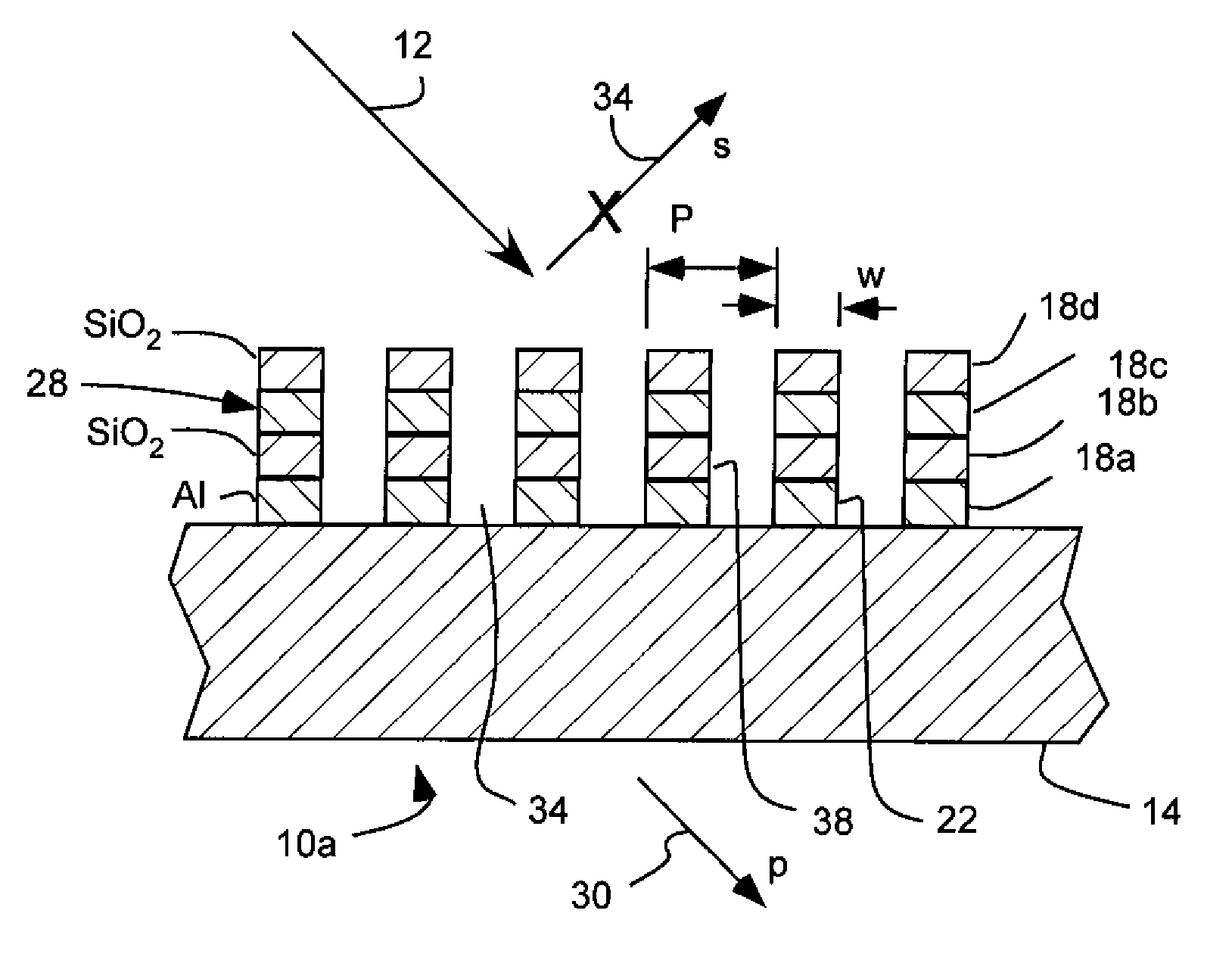Reflection-Repressed Wire-Grid Polarizer
a polarizer and reflection-repression technology, applied in the field of inorganic wiregrid polarizers, can solve the problems of significant cost and weight, polarizers that have not been successfully extended, and poor service of visible spectrum by this technology
- Summary
- Abstract
- Description
- Claims
- Application Information
AI Technical Summary
Benefits of technology
Problems solved by technology
Method used
Image
Examples
example 1
[0053]Referring to FIG. 2a, a first non-limiting example of a reflection repressed, wire-grid polarizer 10f is shown configured for use in the infrared spectrum.
[0054]The polarizer 10f has four layers disposed over a substrate 14 including a polarizing layer 18a, a reflection-repressing layer 18c, a dielectric layer 18b separating the polarizing and reflection-repressing layers, and a second dielectric layer 18d separated from the first dielectric layer 18b by the reflection-repressing layer. The substrate is glass, such as BK7 glass. The first layer or polarizing layer 18a is disposed on the substrate. The polarizing layer 18a is an array of parallel metal wires 22 formed of aluminum (AL) with a period P of 144 nm. The polarizing layer 18a has a thickness of 77 nm. The reflection-repressing layer 18c is formed of niobium siliside (NbSi; n≈3.8, k≈2.90 at 1550 nm) and has a thickness of 50 nm. The first and second dielectric layers 18b and 18d are formed of silicon dioxide (SiO2) and...
example 2
[0056]Referring to FIG. 3a, a second non-limiting example of a reflection repressed, wire-grid polarizer 10g is shown configured for use in the visible spectrum.
[0057]The polarizer 10g has four layers disposed over a substrate 14 including a polarizing layer 18a, a reflection-repressing layer 18c, a dielectric layer 18b separating the polarizing and reflection-repressing layers, and a second dielectric layer 18d separated from the first dielectric layer 18b by the reflection-repressing layer. The substrate is glass, such as BK7 glass. The first layer or polarizing layer 18a is disposed on the substrate. The polarizing layer 18a is an array of parallel metal wires 22 formed of aluminum (AL) with a period P of 144 nm. The polarizing layer 18a has a thickness of 170 nm. The reflection-repressing layer 18c is formed of silicon (Si; n≈4.85, k≈0.8632 at 550 nm) and has a thickness of 12 nm. The first and second dielectric layers 18b and 18d are formed of silicon dioxide (SiO2) and have a ...
example 3
[0059]Referring to FIG. 4a, a third non-limiting example of a reflection repressed, wire-grid polarizer 10h is shown configured for use in the visible spectrum.
[0060]The polarizer 10b has four layers disposed over a substrate 14 including a polarizing layer 18a, a reflection-repressing layer 18c, a dielectric layer 18b separating the polarizing and reflection-repressing layers, and a second dielectric layer 18d separated from the first dielectric layer 18b by the reflection-repressing layer. The substrate is glass, such as BK7 glass. The first layer or polarizing layer 18a is disposed on the substrate. The polarizing layer 18a is an array of parallel metal wires 22 formed of aluminum (AL) with a period P of 144 nm. The polarizing layer 18a has a thickness of 170 nm. The reflection-repressing layer 18c is formed of tantalum (Ta; n≈2.95, k≈3.52 at 550 nm) and has a thickness of 13 nm. The first and second dielectric layers 18b and 18d are formed of silicon dioxide (SiO2) and have a th...
PUM
 Login to View More
Login to View More Abstract
Description
Claims
Application Information
 Login to View More
Login to View More - R&D
- Intellectual Property
- Life Sciences
- Materials
- Tech Scout
- Unparalleled Data Quality
- Higher Quality Content
- 60% Fewer Hallucinations
Browse by: Latest US Patents, China's latest patents, Technical Efficacy Thesaurus, Application Domain, Technology Topic, Popular Technical Reports.
© 2025 PatSnap. All rights reserved.Legal|Privacy policy|Modern Slavery Act Transparency Statement|Sitemap|About US| Contact US: help@patsnap.com



